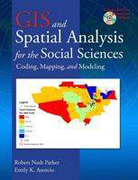
GIS and spatial analysis for the social sciences: coding, mapping, and modeling
Parker, Robert Nash
Asencio, Emily K.
This is the first book to provide sociologists, criminologists, political scientists, and other social scientists with the methodological logic and techniques for doing spatial analysis in their chosen fields of inquiry. The book contains a wealth of examples as to why these techniques are worth doing, over and above conventional statistical techniques using SPSS or other statistical packages. GIS is a methodological and conceptual approach that allows for the linking together of spatial data, or data that is based on a physical space, with non-spatial data, which can be thought of as any data that contains no direct reference to physical locations. INDICE: Preface; Overview; Section I Introduction to Geocoding and Mapping; How to Make a Pin Map; Why Geocode? The Basics of Geocoding; Ex: The Processof Geocoding; Ex: The Science and Art of; Interactive Geocoding; Ex: Exporting a Geocoded Map; Thematic Maps; Ex: Creating a Thematic Map from Sample Data;Ex: Racial Profiling Thematic Map; Ex: Juvenile Crime Thematic Map; Summary of Section I; Section II Mapping for Analysis, Policy, and Decision Making; Basic Multivariate Displays; Mapping Rates; Ex: Classification or World Armed Rivalries; Ex: Subsets of Youth Violence; Ex: Maps for School Planning; Ex: Tessellations and Youth Violence; Ex: Rates of Poverty Over Time in New Orleans; Ex: Patterns of Residency by Ethnicity; Ex: Diffusion of Innovation in the United States; (3D map); Ex: Socioeconomic Conditions in 3D; Ex: Homicide Patterns;Ex: Alcohol Availability and Youth Violence; Ex: Hurricane Katrina's Impact on Children and Schools; Ex: HIV and Armed National Rivalries; Ex: Immigration and Unemployment in the U.S. Ex: California Education System; Summary of Section II; Section III Geospatial Modeling and G.I.S. Why spatial modeling in thisbook? Why spatial modeling at all? The Meaning of Space in Causal Modeling; Measuring the Impact of Space and; Spatial Relationships; Statistical Issues inSpatial Modeling; The Impact of Spatial Autocorrelations and; Error Structures in Spatial Modeling; Statistical Modeling of Spatial Data; Types of Data Used in Spatial Models; Choosing Software to Estimate Spatial Models; Ex: A CrossSectional Spatial Model: Gang Crime; And Alcohol Availability; Ex: Multi-SiteStudies in Spatial Modeling; Ex: Pooled Cross Sectional and Time Series; Spatial Models; Ex: Spatial Models: Limitations, Issues, And Emerging Developments; Conclusion; References; Appendix 1: GIS Data Sources
- ISBN: 978-0-415-98962-6
- Editorial: Routledge
- Encuadernacion: Rústica
- Páginas: 246
- Fecha Publicación: 01/01/2008
- Nº Volúmenes: 1
- Idioma: Inglés
